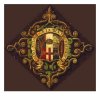While I'm waiting for some needed replacements for the 51xx, I've had these coaches back to me to update and get them running nicely. This is a typical GWR 'M'set. I built these, some years back, for NewportRod. They were to run on Little Mill Junction.

The eagle eyed among you will have noticed that the third coach down has no steps under the doors. That's because I put them on the wrong side when I built the coach and didn't notice this when I handed the coaches over to Rod! Rod was probably too polite to tell me .. so that's been put right with a repaint of the under-frame.
All the coaches are Comet and have Bill Bedford sprung bogies they also use the BB coupling between the coaches. Normally I leave the brake detail off these, for one very good reason. They are a complete bu@@er to get right. And if you're viewing the coaches from 3 foot away, it would be difficult to see them.
There had been some damage to windows while they were in storage and this has been rectified as well. The other item(s) that needed replacement where the corridor connections.
As far as I'm aware there are only 3 places to get these. MJT, Modellers Mecca and Masokits.
It's a while since I looked at the MM range but these appear to have transitioned into a joining piece between commercial products, rather than a a pair of bellows. The MJT paper type are probably quite well known and to my mind are not particularly 'finescale'. The Mike Clarke product is a real finger burner, but with the one kit you can produce the single and double scissored variety of bellows.
As I was Googling away looking for alternatives to these 3 products, I found a new product from Mark Seward (you'll find Mark on Facebook). I won't boor you with the details of the build but this picture gives a comparison of MJT and the new ones.

There's still away to go to set these up properly but to my eye these look like the business. They do take a fair bit of time to build.
The back to backs have all been checked and the brakes have been eased to allow the wheels to move freely. To be honest, these really need an etch where the brakes are all part of the fold-up and not a separate etch to be soldered into place that is soldered to a pivot point.
Work with the 43xx has come to a complete stand still - I'm waiting for a DCC chip to arrive. Soon as it's here it'll get installed and that will be that - except for the weathering, and that's not far off from being started.

Stay safe
Mike















